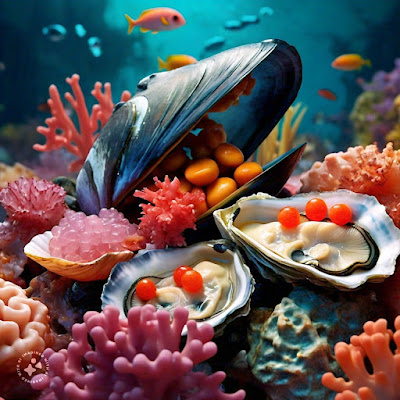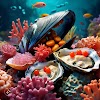introduction
Are you a seafood lover on a quest for the freshest catch and unforgettable flavors? Look no further! In this ultimate guide, we dive deep into the world of seafood delights, uncovering everything you need to know to embark on a mouthwatering journey. From succulent shrimp to delectable lobster, we'll take you on an expedition to discover the finest seafood cuisines that will tantalize your taste buds like never before.
The sea is our playground, and we're here to reveal the secrets of selecting, preparing, and savoring the most exquisite seafood dishes. Whether you're a seasoned seafood connoisseur or a curious newbie, our guide is packed with expert tips and recipes that will elevate your dining experience and leave you craving for more.
Get ready to immerse yourself in a seafood paradise as we unearth hidden gems from coast to coast, uncover regional specialities, and introduce you to culinary traditions that have stood the test of time. So, grab your appetite and join us on this gastronomic adventure as we unveil the wonders of the sea, one plate at a time.
Benefits of eating seafood
Seafood is not only delicious but also comes with a plethora of benefits that make it a wonderful addition to any diet. Rich in essential nutrients, seafood offers a host of advantages for our overall health and well-being.
First and foremost, seafood is an excellent source of lean protein. Fish and shellfish are low in saturated fat and high in omega-3 fatty acids, which are crucial for maintaining heart health. Omega-3 fatty acids have been linked to a reduced risk of heart disease, lower blood pressure, and improved brain function.
In addition to being a great source of protein, seafood is also packed with vitamins and minerals. It is rich in vitamins A, D, and E, as well as minerals like iodine, selenium, and zinc. These nutrients play a vital role in supporting our immune system, promoting healthy skin, and strengthening our bones.
Moreover, seafood has been shown to have anti-inflammatory properties. The omega-3 fatty acids found in fish can help reduce inflammation in the body, which is associated with various chronic diseases such as arthritis, asthma, and certain types of cancer.
Incorporating seafood into your diet can also have a positive impact on your mental health. Studies have found that consuming fish regularly may reduce the risk of depression and improve overall brain function. The omega-3 fatty acids in seafood are believed to play a role in the development and function of the brain and may help protect against age-related cognitive decline.
So, not only does seafood tantalize our taste buds, but it also provides a wide range of health benefits that make it a wise choice for a nutritious and delicious meal.
Types of seafood
The world's oceans and rivers are teeming with an incredible variety of seafood, each offering its unique taste and texture. Let's dive into some of the most popular types of seafood that you can explore on your culinary journey.
- Fish: Fish is perhaps the most widely consumed type of seafood. From mild-flavored white fish like cod and haddock to rich and flavorful options like salmon and tuna, there is a fish to suit every taste. Each variety of fish has its distinct characteristics and can be prepared in various ways, including grilling, baking, frying, or poaching.
- Shellfish: Shellfish encompass a diverse group of seafood that includes crustaceans and mollusks. Crustaceans include shrimp, lobster, crab, and crayfish, while mollusks consist of clams, mussels, oysters, and scallops. Shellfish are known for their delicate flavors and can be enjoyed raw, steamed, grilled, or incorporated into various dishes such as soups, stews, and pasta.
- Cephalopods: Cephalopods, such as squid and octopus, are fascinating creatures that offer a unique seafood experience. With their tender texture and mild flavor, cephalopods are highly versatile and can be prepared in a variety of ways. They are often used in dishes like calamari, stir-fries, and even sushi.
- Crustaceans: Crustaceans are a subcategory of shellfish that includes crabs, lobsters, shrimp, and crayfish. These creatures are prized for their sweet and succulent meat, making them a favorite among seafood enthusiasts. Crustaceans are commonly enjoyed boiled, grilled, or steamed and can be used in a wide range of dishes from salads to seafood boils.
- Mollusks: Mollusks are another subcategory of shellfish that includes clams, mussels, oysters, and scallops. These bivalve mollusks are known for their distinct flavors and can be consumed in various preparations. Clams and mussels are often steamed or used in pasta dishes, while oysters are enjoyed raw or cooked. Scallops, with their tender and sweet meat, are often pan-seared or grilled.
These are just a few examples of the vast array of seafood available for you to explore. Each type of seafood offers its unique taste and culinary possibilities, making it an exciting adventure to experiment with different varieties and preparations.
Choosing and buying seafood
When it comes to seafood, freshness is key to unlocking the best flavors and ensuring the highest quality. Here are some tips to help you choose and buy the freshest seafood for your culinary endeavors.
- Shop at reputable seafood markets: Look for reputable seafood markets known for their commitment to quality and freshness. These markets often have a wide selection of seafood and knowledgeable staff who can guide you in choosing the best options.
- Assess the appearance: When buying whole fish or fillets, pay attention to the appearance of the seafood. The skin should be shiny and firm, and the flesh should be moist and free from any discoloration or strong odors. For shellfish, make sure the shells are intact and tightly closed.
- Check the labels: If buying packaged seafood, check the labels for information on the source, catch method, and expiration date. Opt for seafood that has been sustainably sourced and caught using environmentally friendly methods.
- Consider seasonal availability: Seafood is subject to seasonal availability, so it's a good idea to familiarize yourself with the seasons when certain species are at their peak. Buying seafood in season ensures optimal freshness and flavor.
- Trust your senses: Trust your senses when assessing the freshness of seafood. Fresh seafood should have a mild, clean smell of the sea. Avoid seafood with a strong fishy odor, as it may indicate that it is past its prime.
By following these guidelines, you can ensure that you bring home the freshest seafood possible, setting the stage for a truly unforgettable dining experience.
Storing and preparing seafood
Proper storage and preparation techniques are essential to maintain the freshness and quality of seafood. Here are some tips to help you store and prepare seafood like a pro.
- Storage:
- Refrigerate promptly: As soon as you bring seafood home, refrigerate it promptly to keep it fresh. Store seafood in airtight containers or wrapped tightly in plastic wrap to prevent any cross-contamination and to retain its moisture.
- Follow recommended storage times: Different types of seafood have varying shelf lives. It's important to follow recommended storage times to ensure optimal freshness. Generally, fish and shellfish should be consumed within 1-2 days of purchase, while cooked seafood can be stored for up to 3-4 days.
- Freeze for extended storage: If you're not planning to consume seafood within a few days, freezing is a great option. Properly wrap seafood in freezer-safe packaging, removing as much air as possible, and label with the date. Frozen seafood can be stored for up to 3 months without significant loss of quality.
- Preparation:
- Thawing seafood: When thawing frozen seafood, it's best to do it slowly in the refrigerator. Allow enough time for the seafood to thaw completely before cooking. If you're in a hurry, you can use the defrost setting on your microwave, but be cautious not to partially cook the seafood in the process.
- Cleaning and deveining: Some seafood, like shrimp, may require cleaning and deveining before cooking. To clean shrimp, remove the shell and legs, then make a shallow cut along the back to remove the vein. Rinse under cold water to remove any remaining debris.
- Seasoning and marinating: Seafood can benefit from seasoning and marinating to enhance its flavors. Experiment with different herbs, spices, and marinades to create delicious combinations. Remember to balance the seasoning, ensuring it complements the natural flavors of the seafood rather than overpowering them.
By following proper storage and preparation techniques, you can maintain the quality and freshness of seafood, allowing its natural flavors to shine through in your culinary creations.
Cooking techniques for seafood
Seafood offers a wide range of culinary possibilities due to its versatility and delicate flavors. Here are some popular cooking techniques that will help you unlock the full potential of your seafood dishes.
- Grilling: Grilling is a fantastic way to enhance the natural flavors of seafood while infusing it with a smoky char. It works well for fish fillets, whole fish, shrimp, scallops, and even certain types of shellfish like lobster tails. Brush the seafood with oil or marinade, then grill over medium-high heat until cooked through.
- Baking: Baking is a gentle cooking method that is well-suited for delicate fish fillets and shellfish. It requires less hands-on attention and allows for easy customization with different seasonings and toppings. Simply season the seafood, place it on a baking sheet, and bake at a moderate temperature until cooked.
- Frying: Frying seafood creates a crispy and indulgent exterior while keeping the interior moist and tender. Shrimp, calamari, and fish fillets are commonly fried to perfection. To achieve a crispy coating, dredge the seafood in flour or breadcrumbs before frying in hot oil until golden brown.
- Steaming: Steaming is a healthy and gentle cooking method that preserves the natural flavors and textures of seafood. It works well for shellfish like clams, mussels, and oysters, as well as delicate fish fillets. Steam the seafood in a steamer basket or on a bed of aromatics until it is cooked through and tender.
- Poaching: Poaching is a gentle cooking technique that involves simmering seafood in a flavorful liquid. It is an excellent method for cooking fish fillets, allowing them to remain moist and tender. Poaching liquids can be as simple as water with herbs and aromatics or more complex with wine, stock, or broth.
These are just a few examples of the many cooking techniques you can explore when preparing seafood. Each method offers its unique results, allowing you to create a diverse range of delicious seafood dishes to suit any occasion.
Popular seafood dishes from around the world
Seafood is celebrated in cuisines across the globe, with each region offering its unique twist on seafood dishes. Let's take a culinary journey around the world and explore some popular seafood delicacies.
- Paella (Spain): Paella is a traditional Spanish rice dish that features an array of seafood, including shrimp, mussels, clams, and squid. Infused with saffron and other aromatic spices, paella is a vibrant and flavorful seafood feast that is perfect for sharing with family and friends.
- Lobster Thermidor (France): Lobster Thermidor is a decadent French dish that showcases the rich and succulent meat of lobster. The lobster is cooked in a creamy sauce flavored with mustard, brandy, and herbs, then topped with a gratin crust. It is a luxurious indulgence that is sure to impress.
- Fish and Chips (United Kingdom): Fish and chips are a beloved British classic that has gained popularity worldwide. Crispy battered fish, typically cod or haddock, is served with golden fries and a side of tartar sauce. It's the ultimate comfort food that is enjoyed by people of all ages.
- Sushi (Japan): Sushi is a Japanese culinary art that combines fresh seafood with seasoned rice and other ingredients. From delicate slices of raw fish to rolls filled with crab, shrimp, or eel, sushi offers a wide variety of flavors and textures. It is a true celebration of the ocean's bounty.
- Ceviche (Peru): Ceviche is a refreshing and tangy seafood dish that originated in Peru. Raw fish or shellfish is marinated in citrus juices, typically lime or lemon, which "cooks" the seafood through a process called denaturation. Ceviche is often served with onions, chili peppers, and herbs, creating a vibrant and zesty flavor profile.
These are just a few examples of the diverse seafood dishes you can find around the world. Exploring different cuisines allows you to experience the unique flavors and culinary traditions associated with each region, creating a truly unforgettable dining experience.




.jpeg)


0 Comments